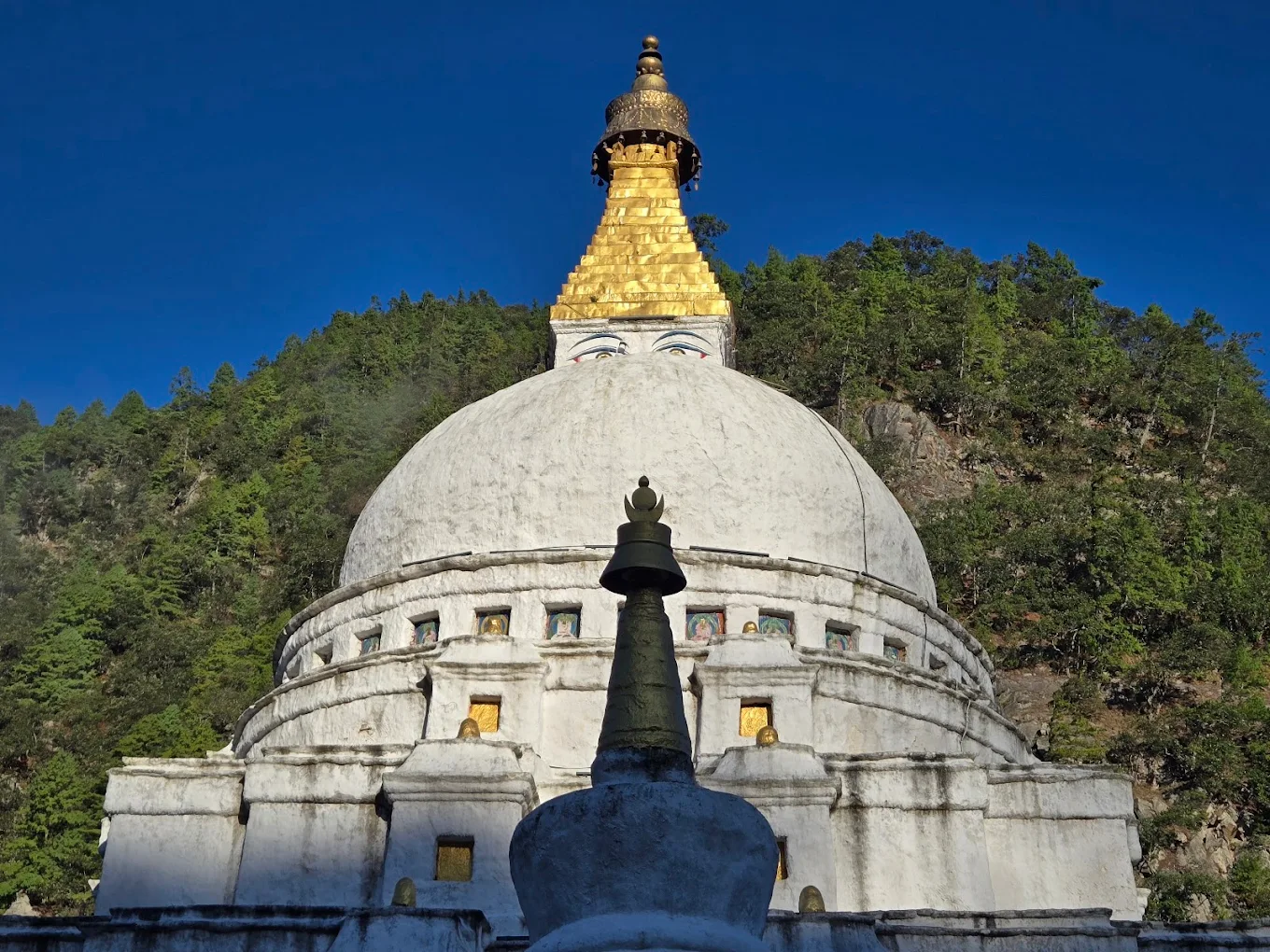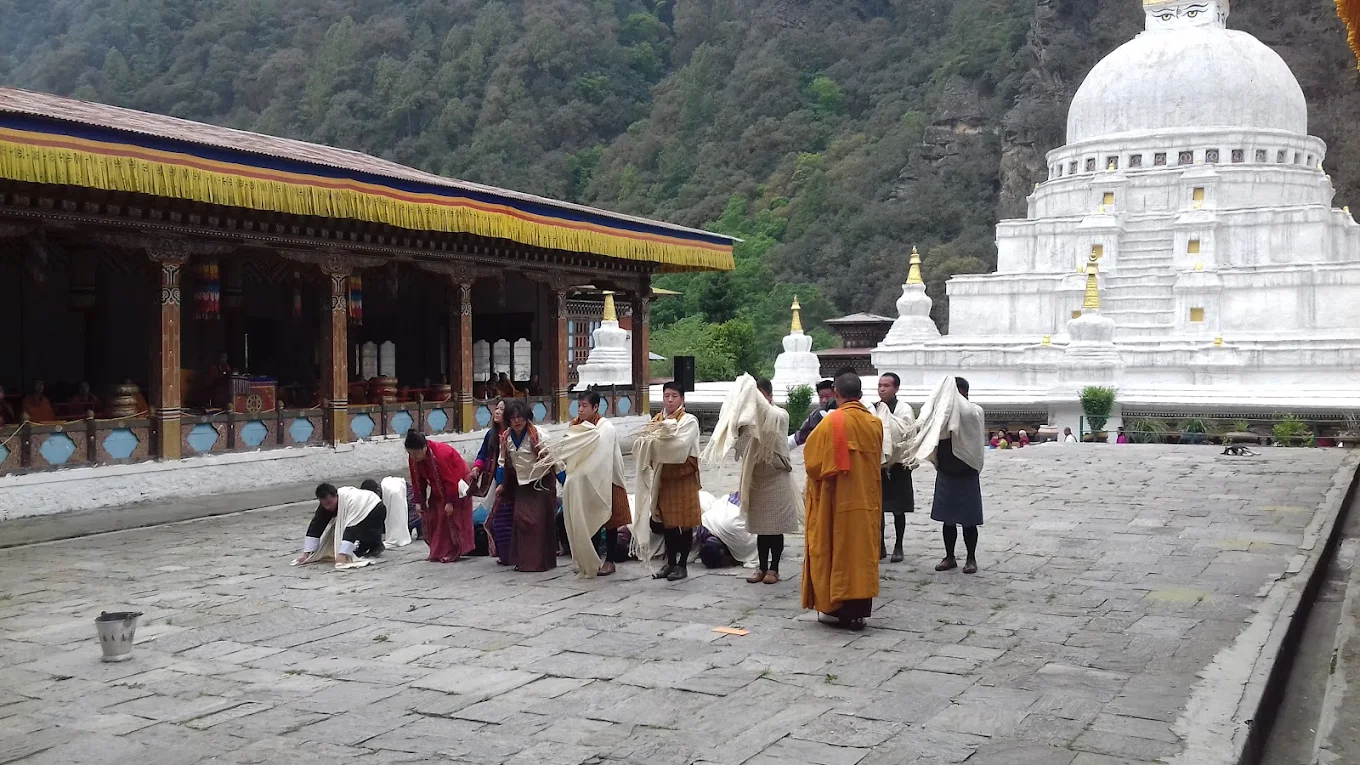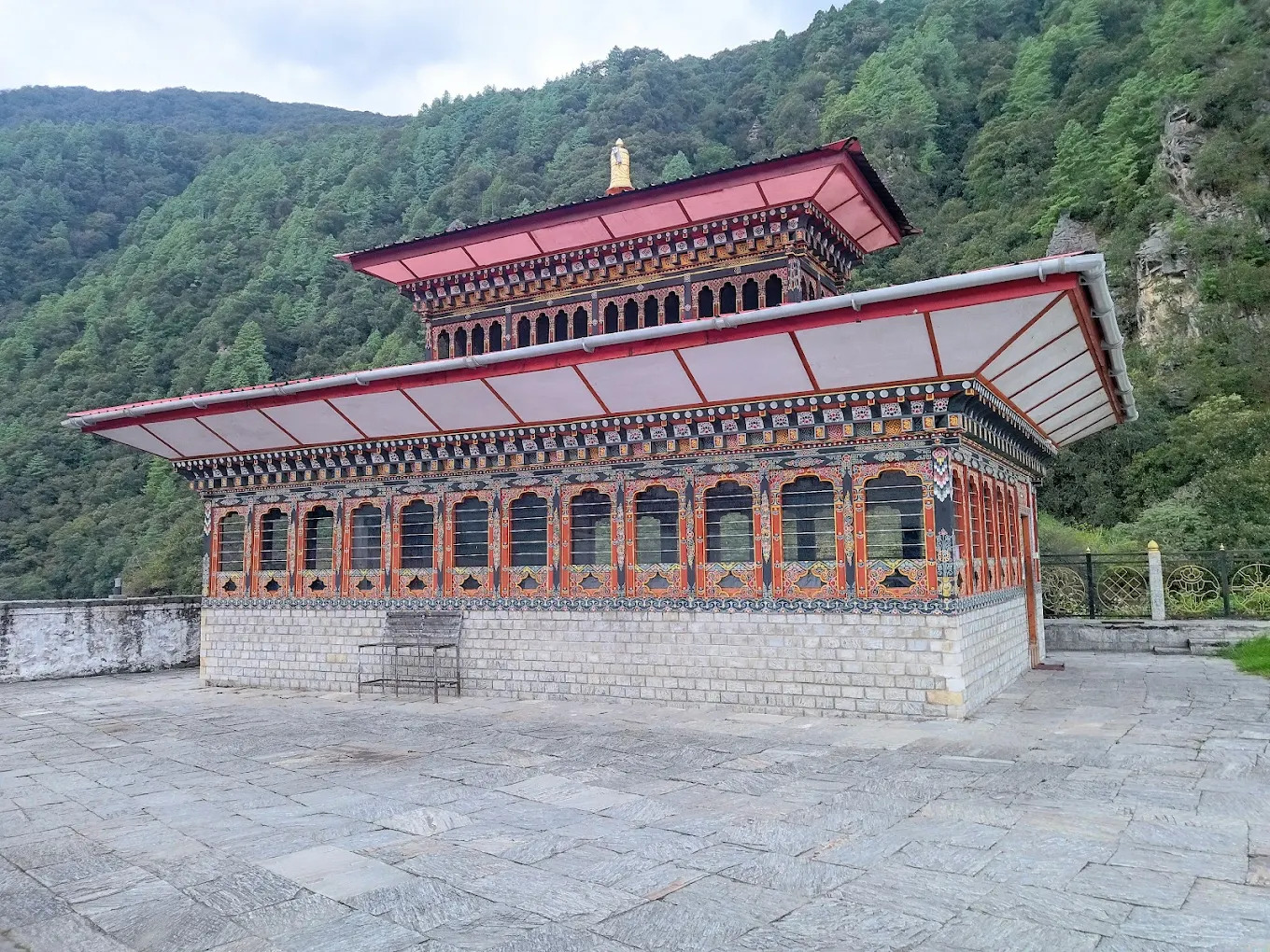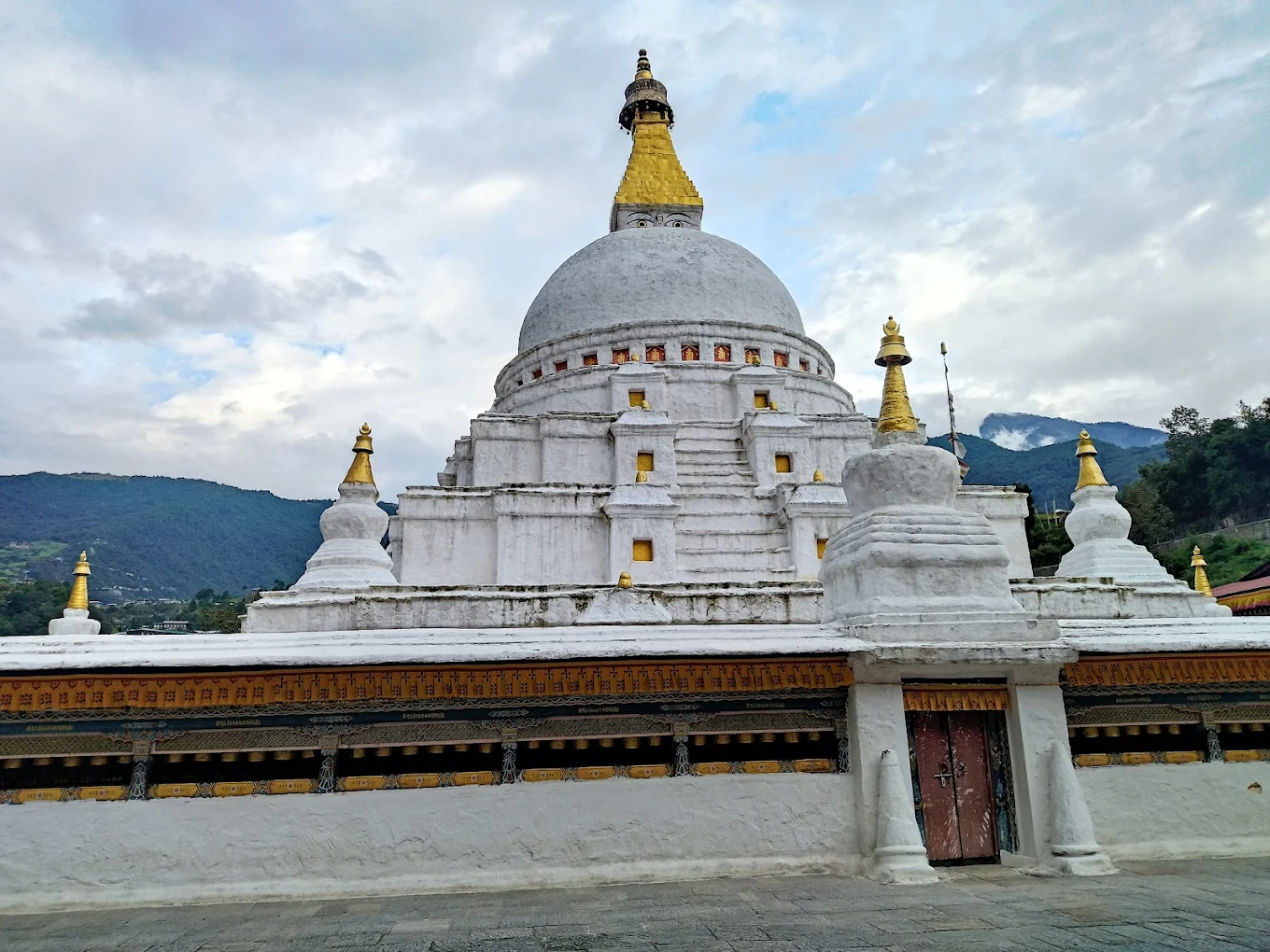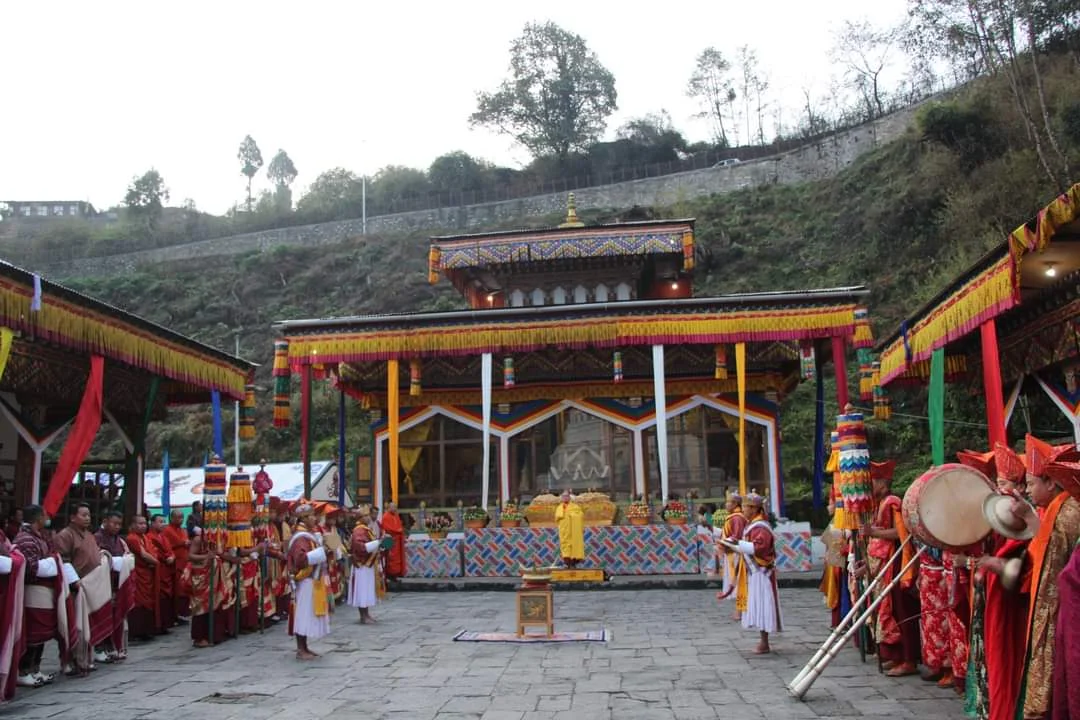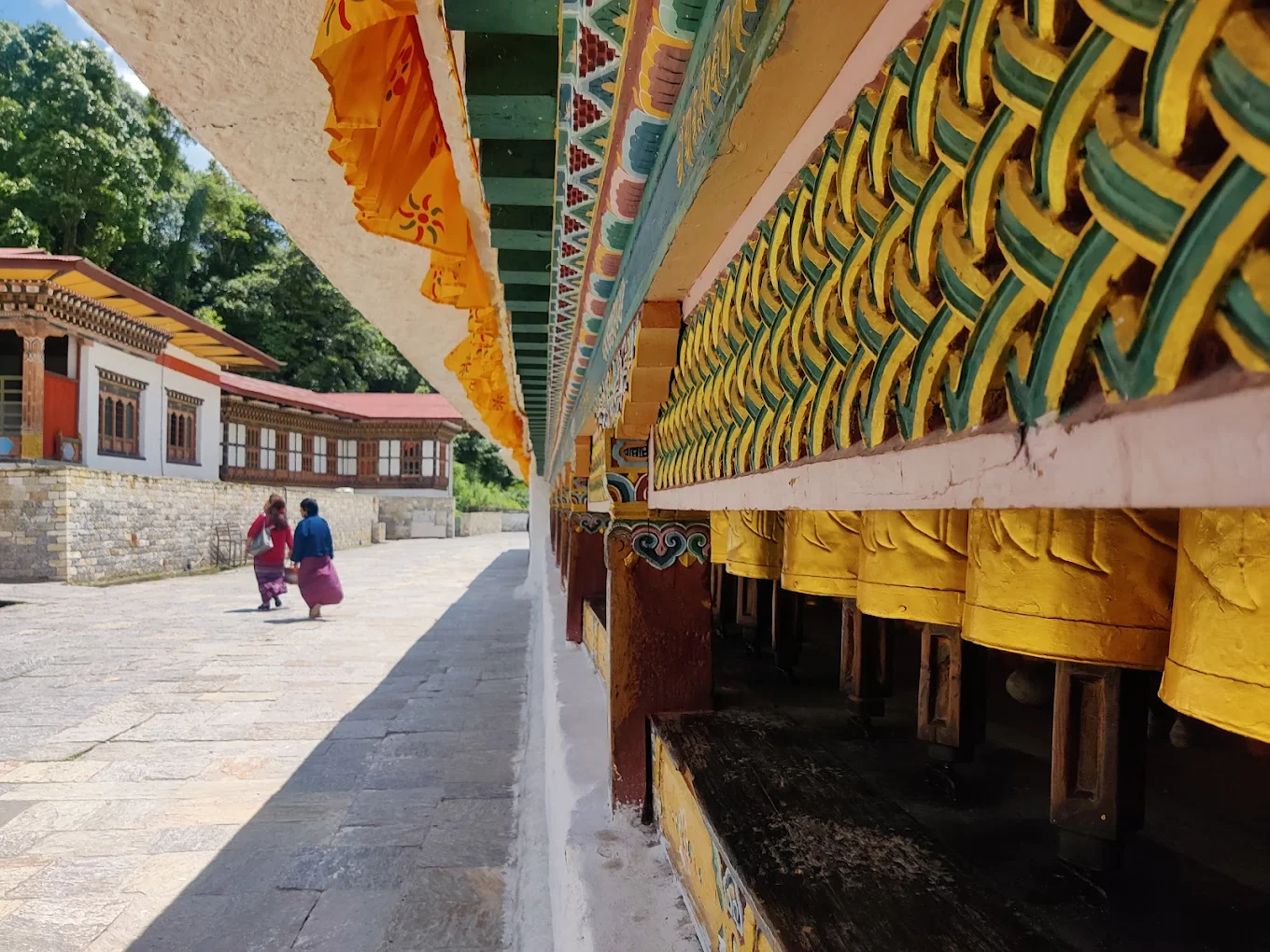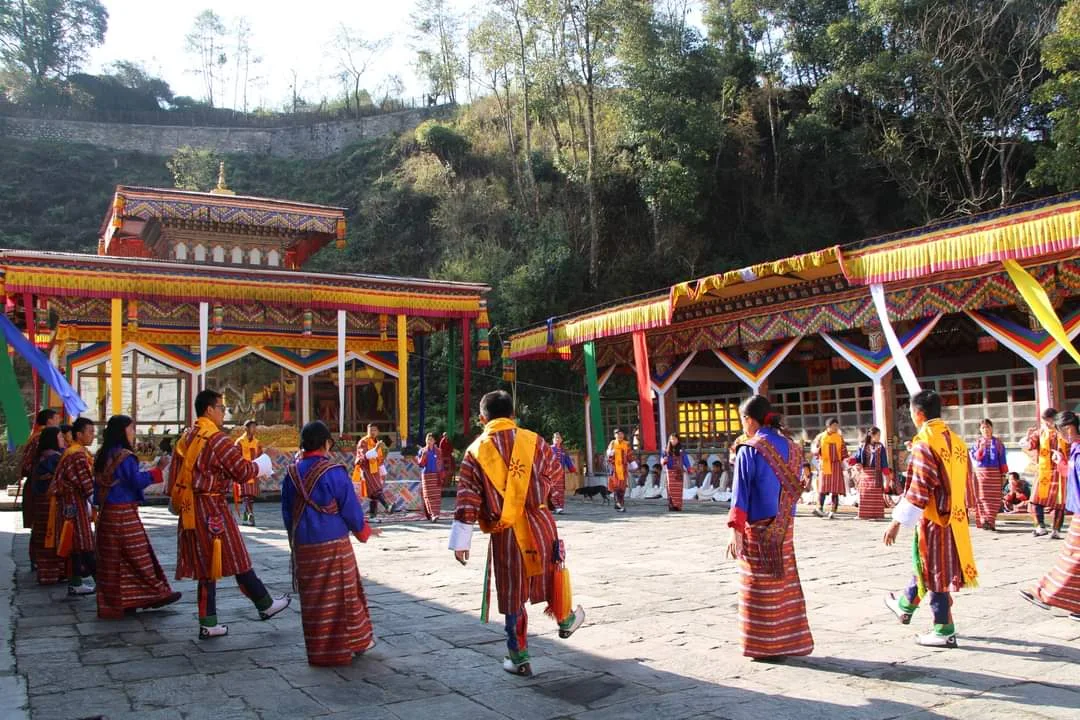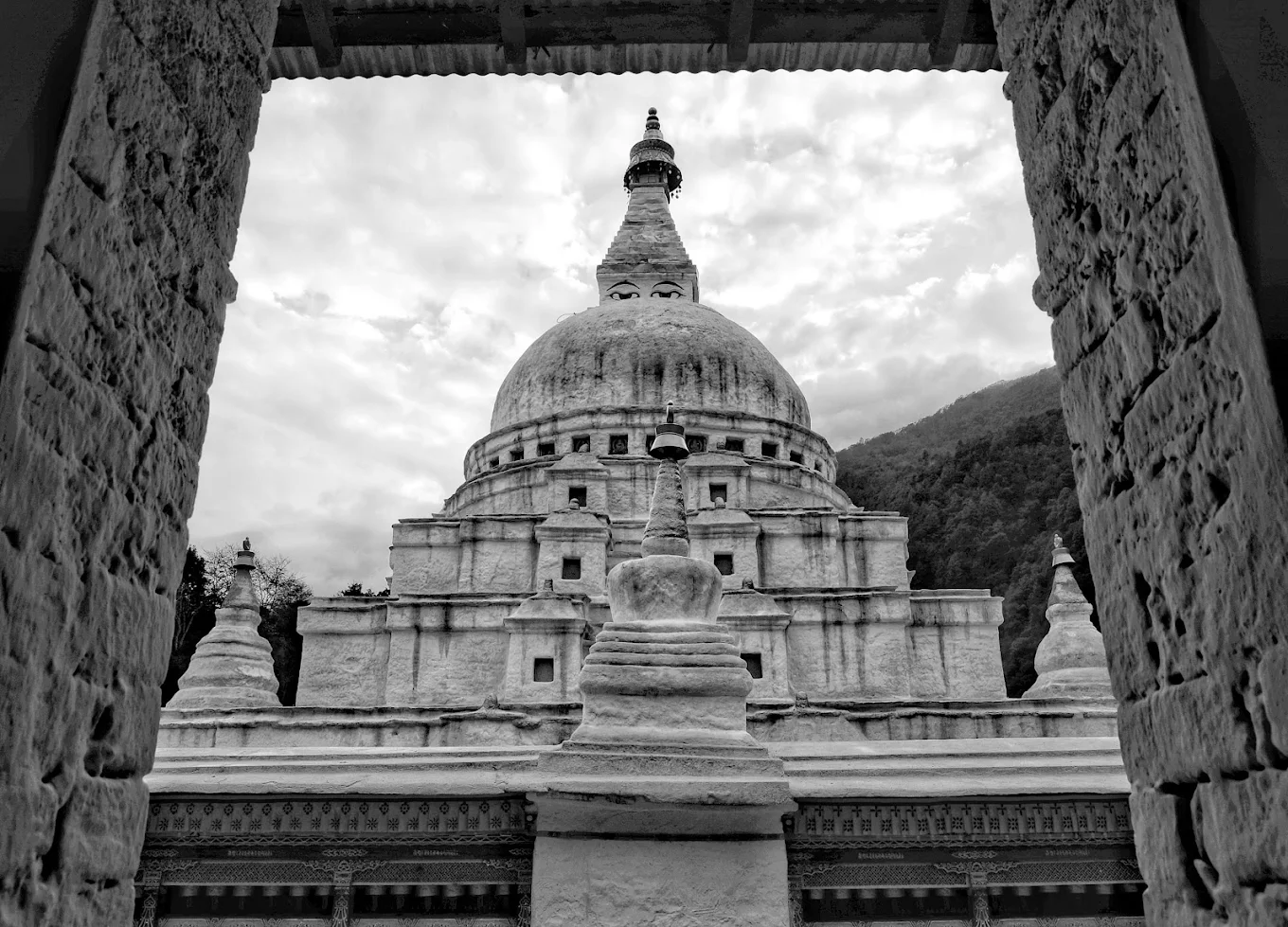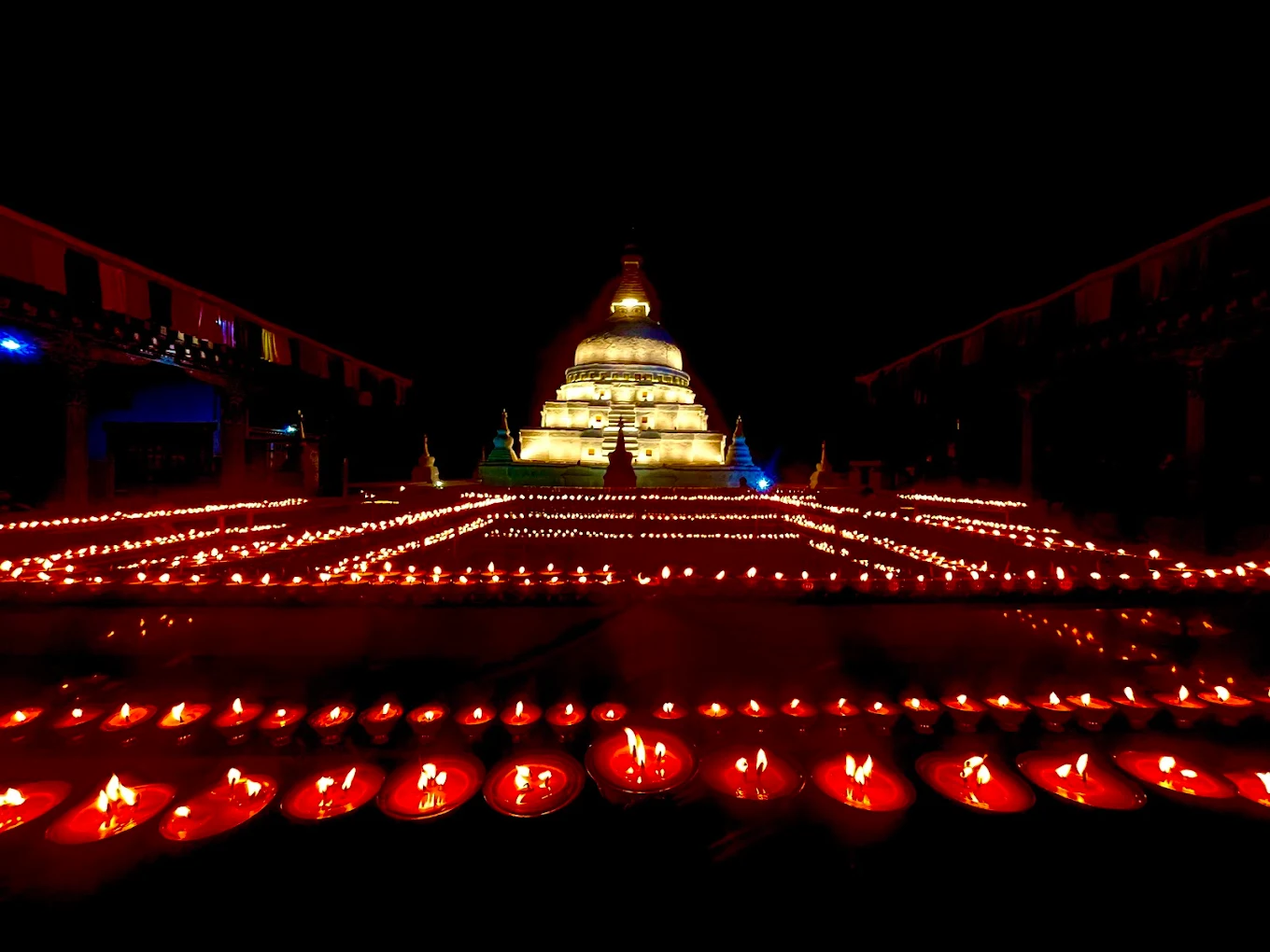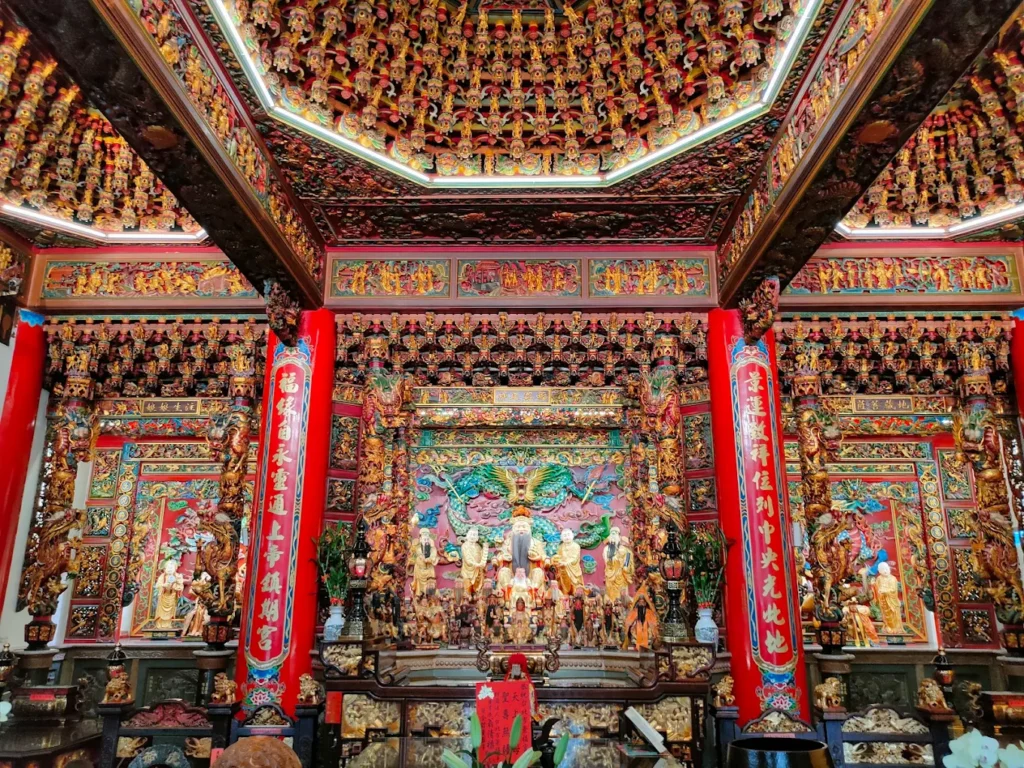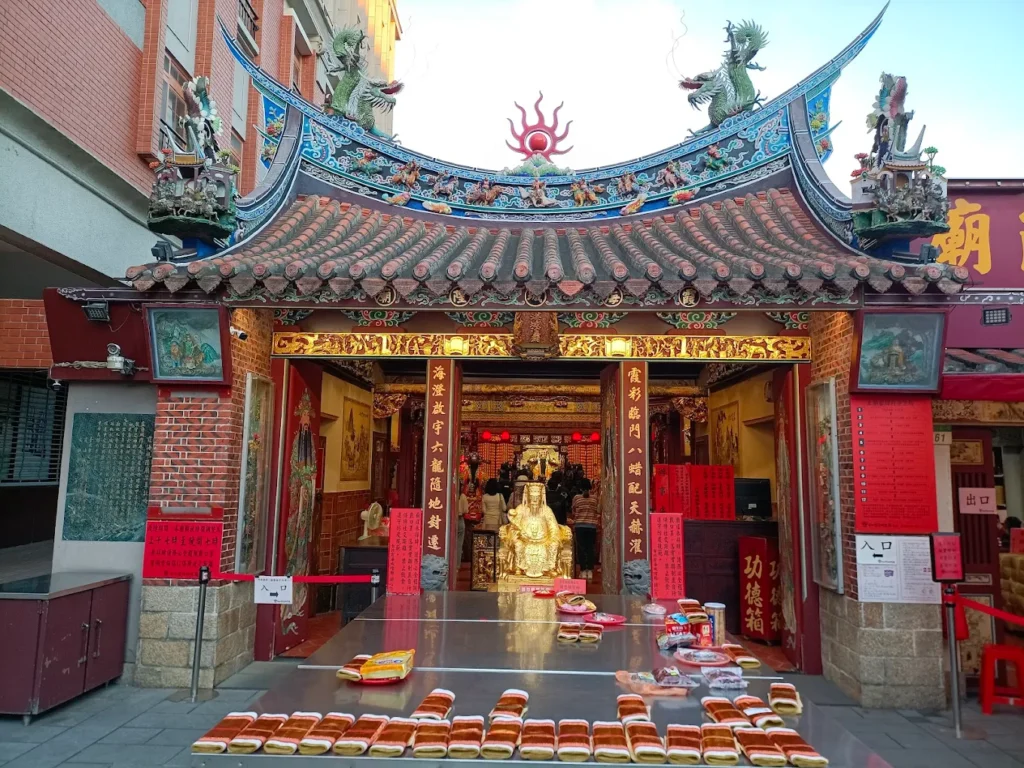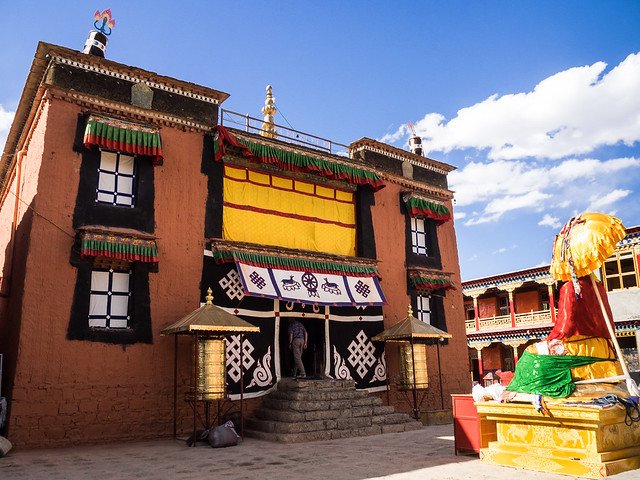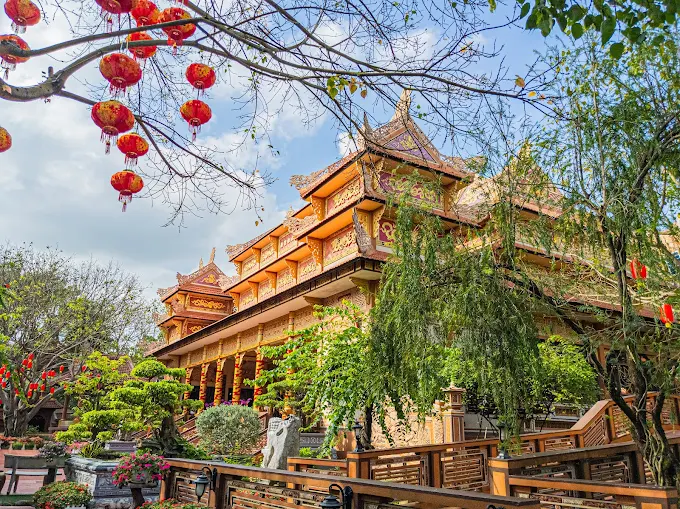Chorten Kora: The Radiant Stupa of Trashigang’s Nyingma Devotion
Rising with serene elegance on a gentle hillock along the Kulongchhu River, where the morning light bathes the terraced fields of Trashigang Valley, Chorten Kora stands as a luminous symbol of spiritual harmony, its white dome glowing softly. Within the sacred interior (lhakhang), monks chant the Om Mani Padme Hum mantra, their voices reverberating around relics of Guru Rinpoche and a statue of Chenrezig, embodying compassion. Constructed in 1740 by Lama Ngawang Lodrö, this Nyingma stupa was modeled after Bodhnath in Nepal, its annual circumambulation festival drawing devotees since its consecration. The air carries the scent of juniper incense, lit during prayer sessions, while prayer flags flutter against the breeze, blessing the valley below. From its riverside perch in Trashigang Dzongkhag, the sweeping vista of terraced landscapes unfolds, connecting the chorten to Bhutan’s spiritual heart. This sacred site invites travelers, seekers, and scholars to circumambulate its base and immerse themselves in the enduring legacy of Nyingma faith.
Whispers of the Stupa: Overview and Significance
Introduction to Chorten Kora
Chorten Kora, gracefully positioned on a hillock along the Kulongchhu River in Trashigang Dzongkhag, Bhutan, stands as a revered Nyingma monument, celebrated for its architectural resemblance to Bodhnath and its annual circumambulation festival. A short walk from the road near Doksum village reveals a peaceful site where the rustle of rice fields and river flow create a serene ambiance. Built in 1740 by Lama Ngawang Lodrö, it embodies Bhutan’s Nyingma heritage, blending pilgrimage with the spiritual legacy of Guru Rinpoche. A cultural and sacred treasure, the chorten weaves history, devotion, and Himalayan reverence into a timeless refuge.
Historical Journey
Chorten Kora’s history began in 1740 when Lama Ngawang Lodrö, at the behest of Yongzin Ngagi Wangchuk, constructed the stupa to subdue a demoness and honor Guru Rinpoche’s legacy. Modeled after Bodhnath in Nepal, it was consecrated with relics brought from Tibet, marking its spiritual significance. The structure faced damage over time, with restoration efforts led by the Bhutanese government and local communities, notably in the 20th century, to preserve its sanctity. The annual circumambulation festival, initiated after its consecration, has endured, reflecting the site’s role as a pilgrimage center in eastern Bhutan.
Cultural Significance
- Nyingma Devotion: Rooted in the Nyingma school, the chorten venerates Guru Rinpoche and Chenrezig, emphasizing meditation and spiritual triumph.
- Bhutanese Heritage: A spiritual anchor, it preserves rituals like circumambulation and mantra recitation, reflecting national identity.
- Pilgrimage Legacy: The Gom Kora Tshechu and local festivals enhance its sacred role.
- Regional Influence: Pilgrimages draw devotees from Trashigang and eastern Bhutan, fostering community bonds.
Unique Legacy
- Bodhnath Model: Its architectural design, inspired by Nepal’s stupa, holds cultural potency.
- Circumambulation Tradition: The annual ritual symbolizes spiritual cleansing, a verified practice.
- Historical Endurance: Survived centuries, reflecting Bhutanese resilience.
- Cultural Symbol: Its demoness-subduing narrative mirrors Bhutan’s spiritual strength.
Community and Global Impact
- Local Devotion: The chorten hosts the circumambulation festival, strengthening Trashigang’s Nyingma ties.
- Pilgrimage Hub: Thousands visit annually, drawn by its stupa and festival.
- Global Appeal: International pilgrims and tourists seek its spiritual and scenic allure.
- Cultural Dialogue: Shared rituals unite Bhutanese and global visitors.
Modern Relevance
- Spiritual Retreat: Chorten Kora offers a haven for mindfulness in its riverside setting.
- Cultural Preservation: It safeguards Nyingma practices, ensuring Bhutan’s heritage endures.
- Festival Influence: The Tshechu inspires global appreciation of Bhutanese spirituality.
Historical Anecdotes
- Guru’s Legacy: His influence led to the site’s consecration in the 8th century.
- Lama’s Vision: Ngawang Lodrö’s 1740 construction honored Rinpoche’s triumph.
- Festival Tales: Circumambulation stories enhance its mystique.
Social Role
- Community Hub: The Tshechu unites Trashigang’s Buddhists.
- Pilgrimage Center: Monks guide devotees in circumambulation rites.
- Charitable Spirit: Communal gatherings reflect Nyingma compassion.
Artistic Influence
- Thangka Art: Murals of Guru Rinpoche inspire Bhutanese artists.
- Cultural Icon: The riverside view graces local imagery.
- Festival Art: Prayer flags showcase Bhutanese craftsmanship.
Chorten Kora’s riverside hillock, where Guru Rinpoche’s legacy was honored, weaves a narrative of devotion and triumph that defines Bhutan’s Nyingma heritage. From its 1740 foundation to its role as a festival site, the chorten’s history resonates with the serenity of Trashigang Valley, uniting monks and pilgrims. Its sacred stupa and scenic trails set the stage for a spiritual tapestry that mirrors its Himalayan soul. As we delve into its physical and spiritual features, Chorten Kora’s design reveals how its radiant beauty nurtures profound faith and pilgrimage.
Crafted by the Hillock: Architectural and Spiritual Features
Iconic Design
Chorten Kora’s architecture blends Nyingma elegance with its hillock setting, creating a monument that harmonizes with Trashigang’s terraced landscape. The whitewashed stupa, topped with a golden spire, rises from the 820-meter elevation, reflecting Buddhist purity. The circular layout, centered on the chorten, prioritizes pilgrimage function, with open spaces fostering circumambulation. Its perch above the Kulongchhu River enhances its sacred resonance, tying the site to Bhutan’s Himalayan ethos.
Key Structures
- Main Chorten: The central stupa, modeled after Bodhnath, built in 1740.
- Interior Shrine: Houses relics and a statue of Guru Rinpoche, added post-construction.
- Circumambulation Path: A stone-lined route around the stupa, used during festivals.
- Prayer Flag Poles: Structures strung with flags, dotting the hillock.
Worshipped Statues and Relics
- Guru Rinpoche (Padmasambhava): A bronze statue, symbolizing victory, radiates spiritual power.
- Chenrezig (Avalokitesvara): A statue with relics, representing compassion, resides inside.
- Spiritual Role: Devotees offer butter lamps to Guru Rinpoche, seeking blessings.
Materials and Techniques
- Construction: Whitewashed stone and timber, joined with traditional methods, ensure durability.
- Artistry: Murals and relics, crafted by early artisans, reflect Nyingma style.
- Cultural Essence: The design prioritizes pilgrimage simplicity, distinct from temples.
Signature Elements
- Bodhnath Design: The stupa’s structure anchors its spiritual narrative.
- Circumambulation Path: The ritual route symbolizes cleansing, a unique feature.
- Prayer Flags: Fluttering flags carry blessings across the valley.
Lesser-Known Features
- Ancient Murals: Paintings inside depict Guru Rinpoche’s deeds.
- Relic Chamber: Houses sacred items brought from Tibet.
- Stone Imprint: A mark on the path, linked to circumambulation lore.
Preservation Efforts
- Restoration (20th Century): Community and government efforts maintained the stupa.
- Challenges: River erosion affects the hillock, requiring care.
- Modern Additions: Solar lights enhance evening accessibility.
Environmental Integration
- Hillock Harmony: The chorten’s design respects Trashigang’s rice ecosystem.
- Eco-Practices: Monks maintain grounds and protect fields.
- Wildlife Haven: Birds nest nearby, enhancing serenity.
Artisan Narratives
- Mural Painters: Early artisans created interior art, preserving Nyingma heritage.
- Stone Masons: Local craftsmen maintained the stupa, blending tradition.
- Flag Weavers: Nuns crafted prayer flags, embedding blessings.
Symbolic Details
- Prayer Flags: Five colors balance elements, spreading dharma.
- Stupa Dome: Represents enlightenment, guiding pilgrims.
- Relics: Symbolize Guru Rinpoche’s victory.
Landscape Integration
- Hillock Perch: Enhances ceremonial focus with river views.
- Kulongchhu Vista: The river’s flow mirrors inner peace.
- Rice Fields: Provide solitude and spiritual resonance.
Chorten Kora’s stone stupa and sacred hillock, overlooking Trashigang’s fields, are more than architectural marvels; they are sanctuaries for the Nyingma practices that define its spiritual soul. The statue of Guru Rinpoche, illuminated by butter lamps, anchors rituals that connect devotees to Bhutan’s spiritual lineage. These hallowed spaces, alive with chants and circumambulation, invite visitors to engage with the chorten’s living traditions. As we explore its rituals, Chorten Kora’s role as a meditative and pilgrimage site comes to life, guiding devotees toward spiritual harmony and victory.
Rites of the Circumambulation: Rituals and Practices
Daily Sacred Rites
- Morning Chanting: Monks recite the Om Mani Padme Hum mantra at dawn, fostering compassion.
- Meditation Sessions: Silent meditation, held twice daily, centers on Nyingma practices.
- Butter Lamp Offerings: Devotees light lamps before Guru Rinpoche, praying for blessings.
Unique Practices
- Cave Meditation: Monks meditate near the cave imprint, honoring Guru’s legacy.
- Circumambulation Ritual: Pilgrims circle the stupa, seeking spiritual cleansing.
- Signature Ritual: Offering khata scarves during circumambulation, tied to the Tshechu.
Festival Traditions
- Gom Kora Tshechu (8th–11th of 2nd lunar month): A three-day festival with night-long circumambulation and cham dances.
- Lhabab Duchen: Ceremonies honor the Buddha’s descent, with chorten circuits.
- Losar (Bhutanese New Year): Monks perform purification rites, blessing visitors.
- Stupa Veneration: The chorten is adorned with prayer flags during festivals.
Visitor Engagement
- Accessible Rituals: Visitors can join chants or circumambulate, guided by monks.
- Offerings: Butter lamps and prayer flags, available at the site, invite participation.
- Nyingma Etiquette: Bow before the stupa and maintain reverence during rituals.
Spiritual Community Roles
- Monastics: Around 10–20 monks maintain the site and lead rituals.
- Lamas: Senior monks guide circumambulation and pujas.
- Lay Devotees: Trashigang villagers maintain grounds and support festivals.
Interfaith Connections
- Syncretic Practices: Some blend Nyingma rites with local traditions, honoring spirits.
- Outreach: The Tshechu welcomes diverse faiths, fostering unity.
- Education: Monks share Guru Rinpoche’s teachings with visitors.
Ritual Symbolism
- Butter Lamps: Represent wisdom dispelling evil.
- Khata Offerings: Symbolize purity and devotion.
- Circumambulation: Signifies cleansing of past actions.
Seasonal Variations
- Spring Rites: Vibrant with rice fields, ideal for Gom Kora Tshechu.
- Winter Ceremonies: Cold enhances cave meditation focus.
- Monsoon Chants: Rain amplifies mantra resonance.
Monastic Life
- Daily Routine: Monks rise at 5:00 AM for chants, meditation, and maintenance.
- Community Service: Monks guide pilgrims and protect the site.
- Training Hub: Monks learn Nyingma practices, supporting Trashigang’s faith.
Chorten Kora’s rituals, from the Om Mani Padme Hum mantra to circumambulation, breathe life into its hillock sanctuary, connecting devotees to the Nyingma lineage. The chorten’s spiritual practices, rooted in Bhutan’s pilgrimage faith, invite visitors to engage with its sacred heart, whether through chants or ritual walks. For travelers, these rites offer a glimpse into Trashigang’s sacred traditions, accessible within its riverside setting. As we turn to visitor information, Chorten Kora’s hillock location guides practical planning, ensuring a meaningful journey to this radiant retreat.
Journey to the Hillock: Visitor Information
Navigating to Chorten Kora
- Location: Trashigang Dzongkhag, 820 meters, accessible via a trail from the road near Doksum village, 24 km from Trashigang town.
- Landmarks: Near the Kulongchhu River and terraced fields, with Dzongkha and English signs.
- Routes: Walk from the road (10–15 minutes) or drive to the hillock base.
Address of Chorten Kora
- Dzongkha: Chorten Kora, Trashigang Dzongkhag, Bhutan.
- English: Chorten Kora, Trashigang District, Bhutan.
Visiting Hours and Etiquette
- Hours: Open daily, 6:00 AM–6:00 PM, with ceremonies varying by schedule.
- Etiquette: Dress modestly, remove shoes before the interior, and respect ritual spaces.
- Nyingma Custom: Offer butter lamps with both hands and bow to the stupa.
Transport Options
- By Foot: Walk from the road near Doksum (10–15 minutes, easy difficulty).
- By Vehicle: Drive to the hillock access point, then walk.
- By Bicycle: A scenic ride suits active visitors to the base.
Accessibility and Safety
- Mobility: Gentle slopes may challenge those with mobility issues; no ramps available.
- Safety: Stable paths with guideposts; carry water for the walk.
- Tips: Wear comfortable shoes and bring layers for weather changes.
Amenities and Surroundings
- Facilities: Basic restrooms near the chorten; no shops on-site.
- Nearby: Gom Kora and Trashigang Dzong, within 20–24 km, offer cultural experiences.
- Dining: Picnic areas encourage packed meals, with options in Doksum.
Immersive Visitor Tips
- Best Timing: Early morning visits offer quiet chants and cooler weather.
- Sensory Moments: Inhale rice-field air and hear river flows.
- Statue Connection: Offer butter lamps at the interior shrine and reflect briefly.
- Festival Planning: Attend Gom Kora Tshechu for circumambulation.
Nearby Cultural Experiences
- Gom Kora: A meditation cave site, 1 km away, offers spiritual depth.
- Trashigang Dzong: A historic fortress, 24 km away, blends defense and spirituality.
- Omba Ney: A cliffside temple, 25 km away, provides sacred insight.
Photography Tips
- Best Angles: Capture the stupa at sunrise for golden light.
- Respectful Shots: Avoid photographing rituals without permission.
- Scenic Views: The Kulongchhu Valley offers stunning vistas.
- Equipment: A smartphone or lightweight camera suffices.
The journey to Chorten Kora, guided by Trashigang’s riverside trails, is a pilgrimage that blends spiritual discovery with sacred ritual, inviting visitors to engage with its Nyingma traditions. The chorten’s hillock and interior, vibrant with chants and circumambulation, offer a window into Bhutan’s sacred heart, where harmony feels profound. Beyond its riverside beauty, Chorten Kora’s deeper cultural and spiritual significance enriches the experience, revealing the essence of Himalayan Buddhism. As we explore these insights, the chorten’s role as a beacon of faith and pilgrimage comes into sharper focus, deepening our connection to its sacred legacy.
Insights of the Hillock: Cultural and Spiritual Reflections
Nyingma Philosophy
Chorten Kora embodies Nyingma’s core: compassion and wisdom through meditation and spiritual victory. Guru Rinpoche inspires devotees, reflected in chants and circumambulation. Dzogchen teachings emphasize direct realization, guiding pilgrims toward enlightenment.
Environmental Spirituality
The chorten’s hillock perch ties it to Himalayan reverence for nature. The Kulongchhu’s flow and rice fields foster meditative calm, with offerings honoring local spirits. The landscape invites reflection on harmony with the natural world.
Artistic Symbolism
Murals depict Guru Rinpoche’s triumph, symbolizing victory over evil. The stupa’s dome represents enlightenment, while prayer flags balance elements. These elements weave Nyingma ideals into the chorten’s aesthetic.
Community Resilience
Built by Lama Ngawang Lodrö’s followers, Chorten Kora reflects Bhutanese perseverance through time. Its restoration showcases collective faith, sustained by community efforts.
Environmental Stewardship
The chorten’s grounds foster Buddhist eco-ethics. Monks protect fields and riverbanks, urging visitors to honor the hillock’s sanctity.
Meditative Practices
Nyingma meditation, including Dzogchen, cultivates awareness. The cave offers spaces for retreat, guided by monks, amplifying inner peace.
Cultural Narratives
- Guru’s Legacy: His 8th-century triumph inspires devotion.
- Circumambulation Tales: Festival stories link past and present.
- Festival Lore: Gom Kora Tshechu carries ancient traditions.
Historical Context
- Nyingma Roots: Guru Rinpoche’s 8th-century visit shaped its identity.
- Lama’s Era: The 1740 construction strengthened its role.
- Community Continuity: Restoration ensures its legacy.
Reflecting on the Journey
Chorten Kora, cradled on Trashigang’s sacred hillock, is a sanctuary where harmony meets wisdom. Its stupa and interior, alive with Guru Rinpoche’s legacy, embody Bhutan’s Nyingma soul, inviting all to seek enlightenment. The chorten’s trails, worn by centuries of pilgrims, tell a story of devotion, rooted in Himalayan faith. Whether meditating near the cave, circumambulating the stupa, or tracing Bhutan’s pilgrimage heritage, visitors find a space to reflect and connect. As you depart, the river’s murmur and prayer flags’ flutter linger, a reminder that peace is always within reach.
